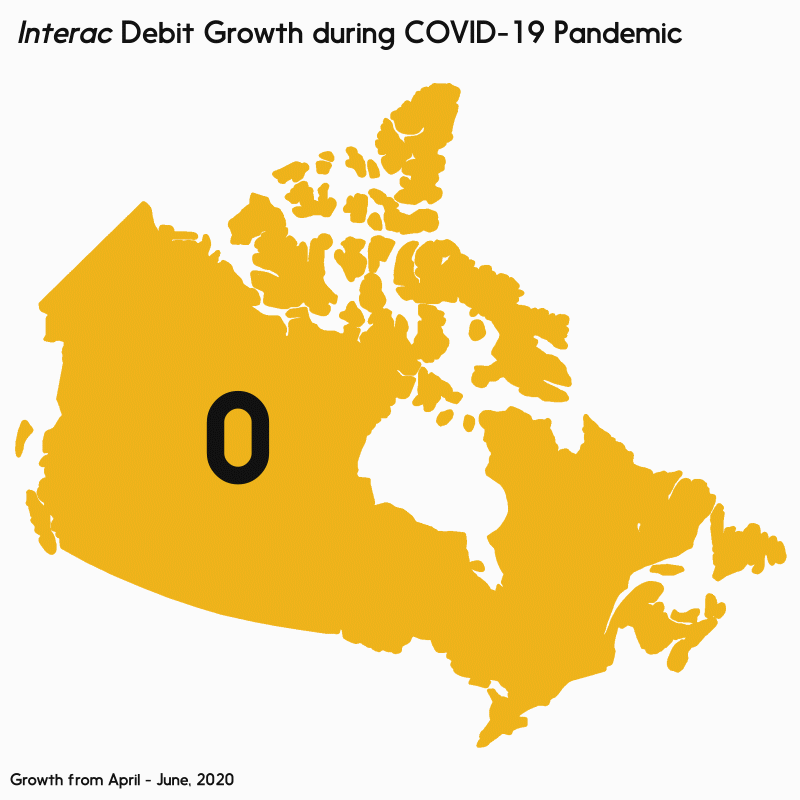The COVID-19 pandemic had an immediate impact on consumer behaviour in Canada. Panic buying ensued almost immediately before spending dipped due to the closure of non-essential businesses. As provinces reopened, Interac Debit transaction data showed where and the rate at which Canadians spent their money — which includes signs of a cautious recovery from the initial COVID shock earlier in the year.
Interac Debit transactions growing nationally
The growth of Interac Debit across Canada since the initial dip in spending shows bright spots in economic recovery. The lifting of COVID restrictions across Canada allowed people to step out and spend at restaurants, hair salons and more. While we haven’t reached pre-COVID-19 spending levels, Interac Debit transactions grew 61 per cent in July since April, the lowest spending point during the pandemic in Canada1.
Provinces hit hardest during the pandemic, including Ontario and Quebec, saw the largest growth in spending as restrictions lifted and businesses were permitted to reopen. In July, Interac Debit spending grew 65 per cent in Ontario and 69 per cent in Quebec since April2.
Provincial reopenings benefited merchants in virtually every industry, as Canadians became more accustomed to shopping and dining with physical distancing restrictions in place.

Hair salons, barber shops, restaurants and food places saw significant growth in spending since provinces lifted COVID-related restrictions
Pent-up demand created a surge in spending at hair salons and barber shops and restaurants and food places. In July, spending grew 6250 per cent and 80 per cent at these merchants respectively since the lowest spending point during the pandemic in Canada3.
Spending growth steadied in provinces further along in their reopening plans. For example, spending at hair salons and barber shops in Manitoba grew 9565 per cent during Phase One4. During Phase Two, Interac Debit spending growth was 64 per cent5.
Contactless payments remain top-of-mind for Canadians
As Canadians become more accustomed to physical distancing restrictions and have an increased focus on hand-hygiene, contactless payment solutions such as Interac Flash become increasingly important. Nationally, Interac Flash transactions grew 64 per cent in July compared to April6. Canadians increased their use of Interac Flash 83 per cent per cent at restaurants and fast food places and 6725 per cent at hair salons and barber shops during the same time period.
Is Interac Debit spending back to normal?
Interac Debit has seen significant growth since April, which is when spending dipped the lowest in Canada during the pandemic. While spending has not yet returned to pre-COVID-19 levels, growth is evident across a number of industries as consumer behaviour evolves and many businesses reopen, either at limited or full capacity. Canadians are becoming more accustomed to shopping with new restrictions and many are choosing to spend using their own money. This is significant as we evaluate the impact the pandemic has had on the Canadian economy.
1: Interac Debit transaction volumes, comparing 03/30/2020 – 04/26/2020 and 06/29/2020 – 07/26/2020
2: Interac Debit transaction volumes, comparing 03/30/2020 – 04/26/2020 and 06/29/2020 – 07/26/2020
3: Interac Debit transaction volumes, comparing 03/30/2020 – 04/26/2020 and 06/29/2020 – 07/26/2020
4: Interac Debit transactions at hair salons and barber shops, comparing 04/12/2020 – 05/03/2020 to 05/04/2020 – 05/24/2020
5: Interac Debit transactions at hair salons and barber shops, comparing 05/04/2020 – 05/24/2020 to 06/01/2020 – 06/21/2020
6: Interac Flash transaction volumes, comparing 03/30/2020 – 04/26/2020 and 06/29/2020 – 07/26/2020
The Contactless Indicator mark, consisting of four graduating arcs, is a trademark owned by and used with permission of EMVCo, LLC.



